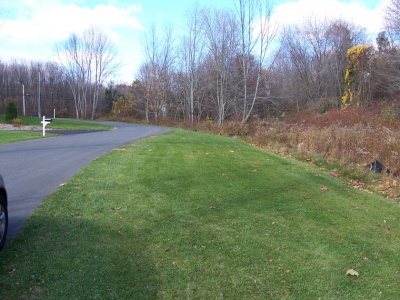Vegetated filter strips
Overview[edit]
Gently sloping, densely vegetated areas that are designed to treat runoff as sheet flow from adjacent impervious surfaces. Filter strips function by slowing runoff velocities and filtering out sediment and other pollutants, and by providing some infiltration into underlying soils. Filter strips may be comprised of a variety of trees, shrubs, and vegetation to add aesthetic value as well as water quality benefits.
They are best suited to treating runoff from roads and highways, roof downspouts and low traffic parking lots. They are also ideal as pretreatment to another lot level or conveyance practice. Filter strips also provide a convenient area for snow storage and treatment.
Vegetated filter strips (buffer strips and grassed filter strips) are gently sloping, densely vegetated areas that treat runoff as sheet flow from adjacent impervious areas. They function by slowing runoff velocity and filtering out suspended sediment and associated pollutants, and by providing some infiltration into underlying soils.
Originally used as an agricultural treatment practice, filter strips have evolved into an urban SWM practice. Vegetation may be comprised of a variety of trees, shrubs and native plants to add aesthetic value as well as water quality benefits.
With proper design and maintenance, filter strips can provide relatively high pollutant removal. Maintaining sheet flow into the filter strip through the use of a level spreading device (e.g.gravel diaphragm) is essential.
Using vegetated filter strips as pretreatment practices to other best management practices is highly recommended. They also provide a convenient area for snow storage and treatment, and are particularly valuable due to their capacity for snowmelt infiltration. If used for snow storage, the area should be planted with salt-tolerant, non-woody plant species. Because of the simplicity of filter strip designs, physical changes to the practice are not needed for winter operation.
Gallery[edit]
Unmown wildflower meadow roadside filter strip/verge in Delft
Filter strips between the bioretention facility and the adjacent parking lot reduce sediment loading to the surface of the bioretention cell. Dennis Ave Health Center, Wheaton, MD. Photo credit: Moreau1
Modeling[edit]
| Surface | |
|---|---|
| Berm height (mm) | This is the height of the curb which constrains the overland sheet flow of water. Where the bottom of the slope discharges directly into another LID facility without impedance, the value is 0. |
| Surface roughness (Manning’s n) | Lower numbers indicate less surface obstruction and result in faster flow. See Turf for ideas of a good number according to mowing practices. |
| Surface slope (%) | If the slope > 3%, consider using level spreaders to reduce erosion of the surface under high flow velocities. |
| Soil (native underlying soil, or amended topsoil) | |
| Thickness (mm) | If topsoil has been amended Absorbent landscapes |
| Porosity (fraction) | Suggest around 0.4, unless otherwise tested. |
| Field capacity (fraction) | Will vary according to native or amended topsoil[1] |
| Wilting point (fraction) | |
| Conductivity (mm/hr) | |
| Conductivity slope | |
| Suction head (mm) | |
| Design drawdown time (hrs) | Will be determined by regulatory authority, often 48 - 72 hours to reduce nuisance from mosquitoes |
- ↑ Oregon State Univ., Corvallis. Dept. of Civil, Construction and Environmental Engineering.; Environmental Protection Agency, Cincinnati ONRMRL. Storm Water Management Model Reference Manual Volume I Hydrology (Revised). 2016:233. https://nepis.epa.gov/Exe/ZyPURL.cgi?Dockey=P100NYRA.txt Accessed August 23, 2017.




